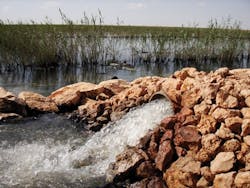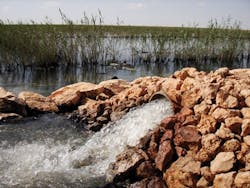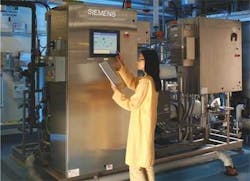First constructed in 1950, the Jackson Gulch Reservoir is a vital resource to resident and visitors of the high mountain regions of Southwestern Colorado. It supplies much-needed water to 13,746 acres of agricultural lands and domestic water to Mesa Verde National Park, Mancos Rural Water Company and the town of Mancos.
When the Jackson Gulch Reservoir infrastructure began to show signs of wear and tear, its owner, the Mancos Water Conservancy District, was justifiably concerned. A condition assessment and recommendation report prepared by Buckhorn Geotech for the district concluded that the 60-year-old concrete structure had retained most of its structural integrity and functionality - with a few exceptions.
The off stream reservoir is fed by the 2.6 mile concrete Inlet Canal that extends from the Mancos River. The Inlet Canal includes a one-mile U-shaped concrete flume that was showing signs of serious deterioration ranging from surface spalling of the floor and joint deterioration to wall blowouts and vertical wall cracks.
Unfortunately, conventional methods of rehabilitation, such as liners, did not provide the long-term, easily repairable solution sought by the district.
Liner Limits
"This is a challenging environment for people and structures," said Norm Aufderheide, an engineer with Buckhorn Geotech. "At 7,000 feet, weather conditions are harsh with an average winter temperature well below freezing. Added to this, access to the flume is limited to a few weeks in August and September when the canal is not operational and ahead of the winter temperatures and snow."
Per the district's request, Buckhorn Geotech initiated a three-year program to test various membrane liners, only to find that conventional liner solutions were not ideal in this environment.
"In the event of a membrane leak, the ability to locate any penetration and create a clean moisture-free repair was a real concern to the district," Aufderheide said. "We opted for a concrete sealer solution instead."
Waterproofing System
Buckhorn Geotech selected the Xypex spray-on crystalline waterproofing system for the project. The firm had successfully used the system on smaller concrete projects with similar deterioration problems. Blended into fresh concrete or spray-coated on existing concrete, the product can seal the paths by which water and aggressive chemicals penetrate, attack, and ultimately threaten the long-term integrity of a concrete structure.
"We selected the crystalline waterproofing system for the repair and protection of the concrete flume because it could be installed in confined spaces as well as the system's ability to seal or heal itself should damage occur to the concrete surface from falling rock or routine maintenance in the coming years," Aufderheide said.
The district agreed. Subsequently, Buckhorn Geotech designed a scope of work to rehabilitate concrete blowouts, scour floors and damaged joints within the concrete flume and then apply a waterproofing and protective coating to the sides and floor.
Sika Corp. materials were chosen for the expansion joint treatment. Mays Construction Specialties based in Grand Junction, CO, was selected as the contractor. Staging, planning and work began in early August 2009 with a scheduled completion date of mid-October to avoid winter weather.
"Living and working in this area, we knew we'd have to overcome a host of challenges to complete the project in the approximately eight week timeframe from meeting regulatory requirements to dealing with continually changing, and often, extreme weather conditions," said Stuart Reed with Mays Construction Specialties.
Site Preparation
The mile-long, U-shaped flume is about 10 feet wide with six-foot walls on either side. The first step in the rehabilitation project involved removing and disposing of test liners that had been put in place during the three-year liner testing program.
While removing the liners was not difficult, Mays Construction crews also had to remove the residue and glue from the concrete surfaces. Much of this was done by hand grinding with a diamond-grinding disk or sandblasting. As well, all water pumping, storage equipment, and cleaning equipment had to be washed, cleaned, dried out, and inspected by the Colorado Division of Wildlife to be clean and free of aquatic nuisance species (zebra mussels) prior to arrival on the jobsite.
With the residues removed, crews proceeded to power wash the entire flume with 3000-psi pressure washers to clean the concrete surface for proper bonding and acceptance of the coating.
"Cleaning the flume proved time consuming," Reed said, "though the bigger challenge was keeping the flume dewatered and dry during this process."
There were some rainy days and afternoon high country thunderstorms that would leave a couple inches of water in the flume, which Mays Construction crews had to remove before they could continue the repair and coating process.
"To meet the tight schedule deadline, we had to get a little creative. We had a team of about a dozen guys at any one time washing and dewatering the flume with squeegees, brooms, pumps and another crew running an ATV with a squeegee blade on the front to push the water and debris."
The Mays Construction crew used Xypex Megamix repair material to repair the blowouts of the control joints. The contractor relied on Xypex's Colorado representative, Stephen Boyd, throughout the clean and repair process to verify that the flume concrete was effectively prepared for the spray-on coating. Boyd also approved the crack and wall repairs and, ultimately, the coating preparation.
Dewatering, Waterproofing
Once they had cleaned and prepped the flume, the Mays Construction crews proceeded to coat the walls and floors with the Xypex Concentrate and Modified using an Essex spray machine. Crews pumped the mixed material through 200-foot hoses to a nozzle that sprayed the material onto the flume's concrete surface.
On average, Mays Construction sprayed 10,000 square feet per day of the waterproofing and protection application. Mays Construction, Buckhorn Geotech and Xypex representatives held weekly meetings with Mancos Water Conservancy District Representative and performed daily inspections to ensure proper water control.
"Our quality assurance team checked bag counts every day to make sure we were achieving proper coverage throughout the flume," Reed said.
The coating process was finished in late September.
Flume Finale
Because Mays Construction and the rest of the team were able to complete the inlet flume repairs on schedule and the weather was still good, the district requested that the team repair the outlet flume as well. The Jackson Gulch outlet canal flume is about 900 feet in length. It did not require any concrete repair or expansion joint installation. Crews once again used the Essex spray equipment to coat the walls and floors with Xypex Concentrate and Modified. WW
More WaterWorld Current Issue Articles
More WaterWorld Archives Issue Articles





